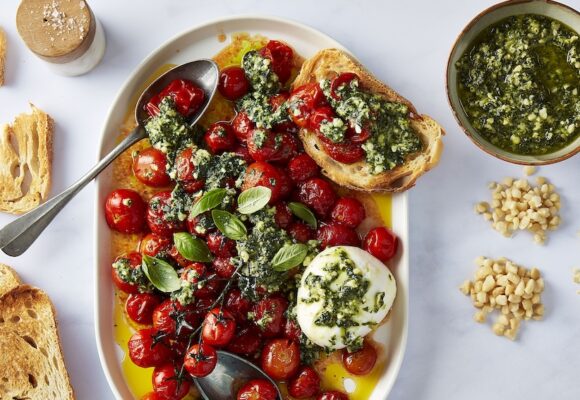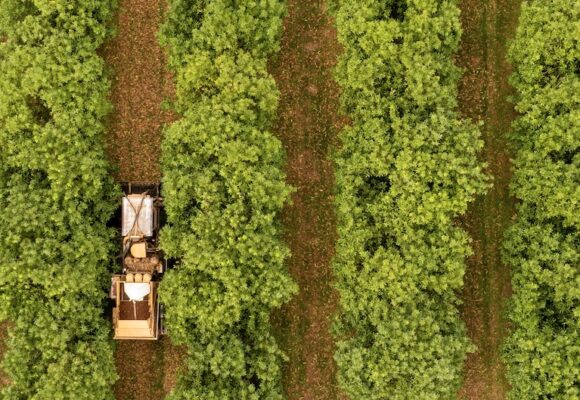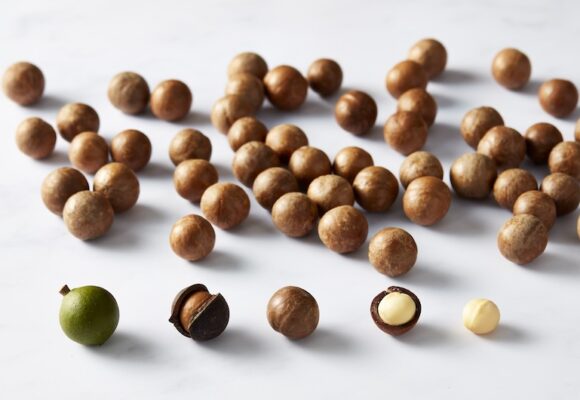Premium food products are a customary gift in Japan, with many Japanese seeking out irresistible delicacies to present when visiting close friends and family. Macadamias feature in some truly exquisite edible Japanese souvenirs, with manufacturers reaping the many benefits they offer as an ingredient. Let’s take a closer look at three of the most unique.

Fried Manjyu from Ginza Kikunoya
Ginza is a popular shopping, dining and entertainment district set in the heart of Tokyo. Here you’ll find iconic store Ginza Kikunoya, home to an array of ‘Edo Wagashi’ –traditional Japanese confectionery. Set among the impressive product range is Macadamia Fried Manjyu, steamed buns filled with sweet Azuki (red bean) curd, coated in roasted macadamia nuts and fried.
Ginza Kikunoya has a fascinating history dating back 126 years when it was a kimono cleaning business. Back then the store had a large central garden where customers would wait while their kimonos were being washed. The store’s owner would serve his customers delicious and dainty sweet Japanese confectionery with tea. These sweet treats became so popular that eventually, the owner abandoned the kimono cleaning service and began selling confectionery full time. Today, the business is still owned by descendants of the store’s original owner, the Ida family.
While their classical Japanese confectionery is still the signature product of Ginza Kikunoya, the Macadamia Fried Manjyu have become so popular they often sell out within hours of being made. They’re the creation of Mr Tsunemichi Ida, a fourth generation member of the Ida family, who had the idea while preparing for a trip to Australia around 2003, when he was invited by the state of Queensland to run a seminar showing newly established Australian Azuki bean growers how to grow and use their crop.

Wanting to present some souvenirs to his hosts in Australia that showcased not only Azuki but also the use of Australian ingredients in Japanese confectionery, Mr Ida’s Macadamia Manjyu was born.
As Ginza Kikunoya sales manager Ms Watanabe explains, “When creating his new Manjyu Mr Ida tried all kinds of nuts including almonds and peanuts, but came to the conclusion that macadamias from Australia were the best match.”
Kikunoya’s red bean paste is not overly sweet. When the bean paste and just-fried crispy bun combine with roasted macadamias, Ms Watanabe says it’s hard to find the words to describe how delicious it is. “There’s nothing that compares to the taste and texture. We should be thankful that Mr Ida worked so tirelessly to create this Manjyu!” she says. Mr Ida retired last year and now the fifth Ida generation continues to make the Macadamia Fried Manjyu fresh every day, one by one.
Ms Watanabe recommends enjoying them with your favourite alcoholic refreshment. “Sake, wine, whisky, sparkling wine…they match with everything,” she says.
Brown sugar macadamias from wara no bag
“My own health is the earth’s health.” This is the mantra of Mr Takahama, owner of wara no bag, a nut and dried fruit store in Odawara, located an hour by train from Tokyo. With its charming straw bag logo representing the concepts of handmade and nature, wara no bag is dedicated to offering nut and dried fruit products that enhance the wellbeing of the people who eat them, and thereby the health of the earth. The store’s signature product is its brown sugar macadamia nuts, hand made by Mr Takahama.

wara no bag’s brown sugar macadamiasHaving studied the food industry at university, he found inspiration in mountain conservation and natural farming practices. However his post-graduate experience took him in the opposite direction, and he spent two years working for a fast food company.
It was during this time, while eating copious amounts of macadamias during a trip to Hawaii, that the idea for his product started to form. “When I was a young boy, I remember my father would coat walnuts in brown sugar. While I was eating macadamia nuts in Hawaii, I started to think they would also be great matched with brown sugar,” he said.
However Mr Takahama’s idea was put on the back burner when a catastrophic earthquake and tsunami hit Japan in March 2011, causing widespread devastation. It was several months before he was able to revisit his plan to develop a brown sugar coated macadamia product. “I finally tried what I wanted to do and I thought ‘This is it!’ In September I quit my job and started selling my brown sugar macadamias online.”
To find the macadamias that paired best with brown sugar, Mr Takahama trialled kernel from a variety of origins before deciding on Australian grown macadamias. “Macadamias grown in Australia have a lovely round shape and the best flavour for the Hateruma Island brown sugar that I use, which is a strong, slightly bitter sugar. Both the Australian macadamias and the sugar are produced by people who take great care during the growing process,” Mr Takahama explained.
Although Mr Takahama understands the need for efficiency, he says some things can only be made well by hand. “The delicious flavour of my products can only be created by me,” he says.
The brown sugar macadamias are available from the wara no bag store in Odawara and online. And while they’re delicious just as they are, Mr Takahama has a tip for another way to enjoy his popular product. “They can also be eaten frozen,” he says. “The brown sugar becomes crispy on the outside and the macadamia becomes a bit harder. It creates an interesting texture.”
Macadamia Okaki from Nigata Ajinoren Honpo
While a love of rice crackers is not unique to Japan, it could be said that the Japanese take their rice crackers more seriously than most, with a variety of styles to choose from, and great care put into the manufacturing process.
The more standard style of rice cracker in Japan is known as Senbei, made from ordinary rice. However there is another type of rice cracker called Okaki. Made from ‘Mochi’, a steamed sticky rice cake, it has a distinctly different taste and texture.
Nigata Ajinoren Honpo is a subsidiary company of Iwatsuka Seiki, a Japanese rice cracker manufacturer in the Nigata prefecture, known for its premium rice crackers made from high quality Japanese rice. Interestingly, since its establishment in 1988, the company has employed solely women, with the exception of its CEO, and is said to have created products using women’s ‘sense and taste.’
In 1995, the company launched its unique Macadamia Okaki, and it has enjoyed enormous success ever since. According to Ajinoren Honpo CEO Mr Watanabe, the product was an important innovation for the business. “Our top selling product since our establishment had been Koshi No Mame Mochi, a rice cracker with Hokkaido soy beans in it. It’s good to have a popular stable sales product, but we wanted to have something new, to tap into emerging trends. So we tried a number of alternatives to the soy bean, one of them being macadamias,” he reveals.
Mr Watanabe says macadamias’ unique texture was one of the reasons they worked so well in the product. “Our crackers have a soft fluffy texture,” he says. “If we combine them with a hard ingredient, the imbalance creates a strange texture when eating. However, macadamia nuts have a naturally soft texture and this matches perfectly with the soft fluffy texture of the cracker.”

It’s the quality of the ingredients that make Macadamia Okaki a simple, yet delicious product. The rice is grown in the Nigata prefecture in northern Japan. It’s an area renowned for its clear water and good soil, and it’s trusted by Japanese people as a source of premium quality rice.
“When the sweetness of good quality Japanese rice and the sweetness of good quality macadamia nuts combine with a touch of salt, just one bite will make you want to shout “Delicious!”” Mr Watanabe says. “The macadamias are cut into very small pieces specially for this product, and the texture and mouth-feel are exquisite. It’s these small details that make the product so special. They’re very light – it’s hard to stop eating them!”
While Okaki has traditionally been perceived as a snack enjoyed by older people, the company has noticed a shift to a younger customer base, brought about by the increasing popularity of nuts. The fluffy texture of the Macadamia Okaki makes them a popular cracker for young children as well, and they’ve become a snack the whole family can enjoy.

As for the best way to enjoy these unique rice crackers, Mr Watanabe’s recommends pairing them with coffee. “We even sell coffee that has been specially blended to match the flavour of our Macadamia Okaki,” he says.


